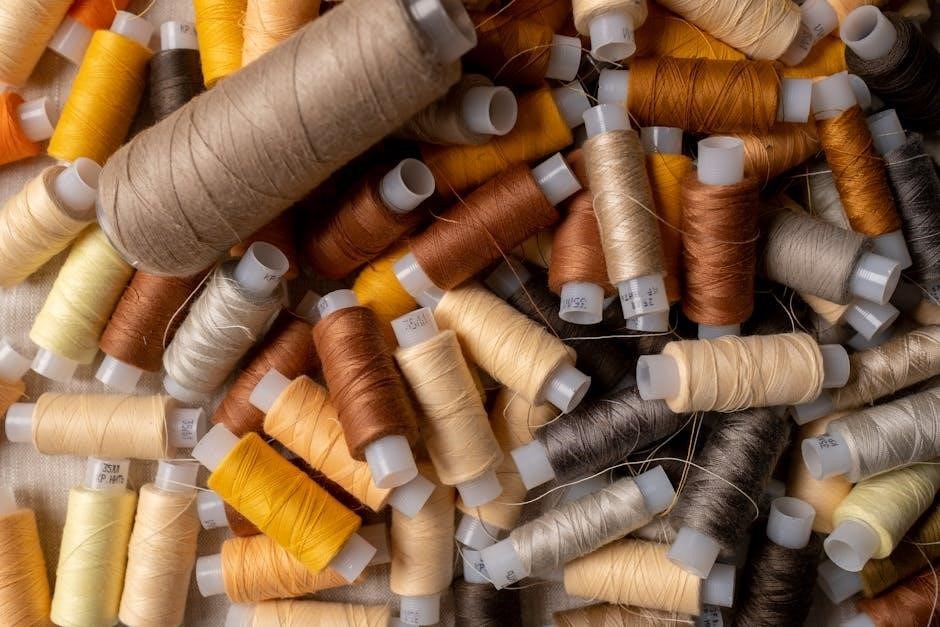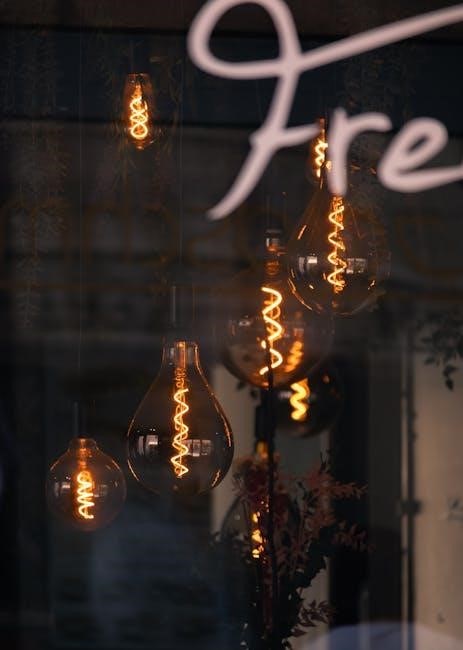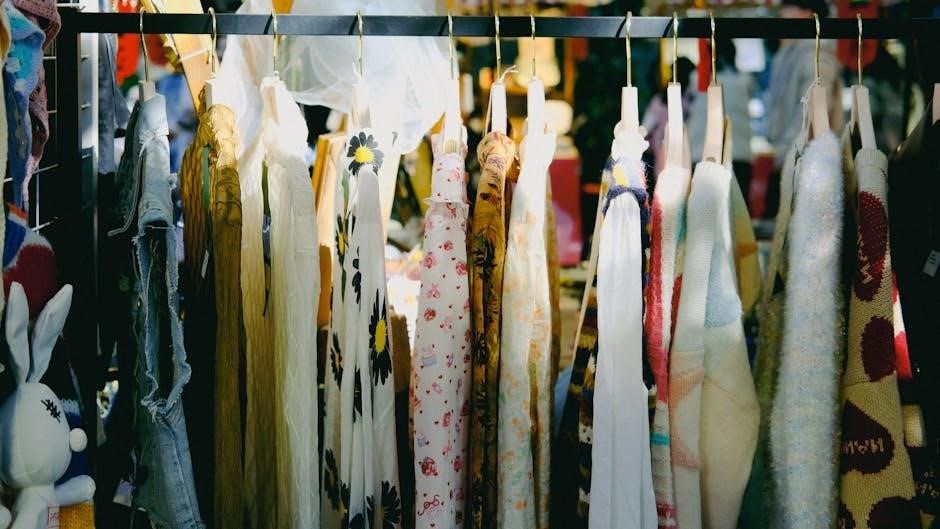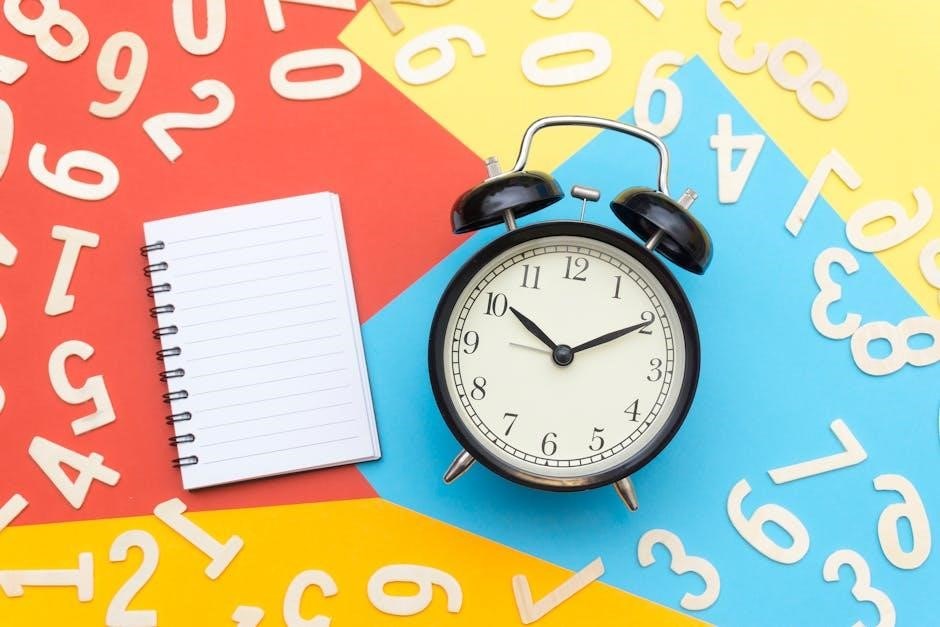
knitting patterns free download pdf
Knitting patterns are essential guides for crafters, offering step-by-step instructions for creating garments, accessories, and home decor. They come in various forms, including free downloadable PDFs online.
1.1 What Are Knitting Patterns?
Knitting patterns are detailed guides that provide step-by-step instructions for creating specific knitting projects. They typically include information on stitches, yarn requirements, measurements, and techniques. These patterns can be used to craft a wide range of items, from clothing and accessories to home decor. Patterns are often tailored to different skill levels, making them accessible to both beginners and experienced knitters. They can be found in various formats, including free downloadable PDFs, which are popular for their convenience and ease of use. Whether you’re making a simple scarf or a complex garment, knitting patterns serve as essential blueprints to ensure your project turns out as intended.
1.2 The Importance of Knitting Patterns for Crafters
Knitting patterns are indispensable for crafters, providing clear guidance and ensuring projects turn out as envisioned. They offer step-by-step instructions, helping crafters achieve professional results. Patterns eliminate guesswork, making knitting accessible to all skill levels. They also foster creativity by offering customizable designs, allowing crafters to personalize projects; Additionally, patterns save time by outlining materials and techniques, preventing errors. For beginners, they serve as educational tools, teaching essential skills. Experienced knitters benefit from new techniques and inspiration. Overall, knitting patterns empower crafters to create confidently, explore their creativity, and enjoy the satisfaction of handmade items. They are a cornerstone of knitting, making the craft enjoyable and rewarding.
1.3 Overview of Free PDF Knitting Patterns
Free PDF knitting patterns are widely available online, offering a convenient and affordable way to explore various knitting projects. These downloadable files provide detailed instructions, charts, and photos to guide crafters through creating garments, accessories, and home decor items. Many free PDF patterns cater to different skill levels, from beginners to advanced knitters. They often include customizable options, allowing crafters to personalize projects based on preferences or available materials. With the ability to print or save digitally, these patterns offer flexibility for crafting on the go. Whether you’re making a cozy sweater or a intricate lace shawl, free PDF knitting patterns are a valuable resource for any knitting enthusiast.

Benefits of Free PDF Knitting Patterns
Free PDF knitting patterns offer crafters cost savings, instant access, and versatility. They provide a wide range of designs, are easily downloadable, and convenient for organization and reuse.

2.1 Cost-Effective Crafting
Free PDF knitting patterns offer a cost-effective way to enjoy crafting without financial strain. Crafters can access high-quality designs without purchasing expensive books or magazines, making knitting more accessible to everyone. This affordability allows hobbyists to explore various projects, from scarves to sweaters, without budget concerns. Many free patterns are created by talented designers who share their work generously, ensuring a wide range of styles and techniques are available. Additionally, downloadable PDFs eliminate the need for physical storage, reducing clutter and making it easier to organize your collection. This accessibility encourages creativity and experimentation, fostering a vibrant knitting community. Embrace the savings and start crafting with ease!
2.2 Access to a Wide Variety of Designs
Free PDF knitting patterns offer crafters an incredible array of design options, catering to diverse skill levels and preferences. From classic sweaters to intricate lace shawls, the variety is vast. Crafters can explore patterns for seasonal items, baby clothes, home decor, and accessories. The availability of free designs allows beginners to experiment without financial commitment, while experienced knitters can discover unique and complex projects. Many patterns include customizable elements, enabling personalization to suit individual tastes. This diversity fosters creativity and ensures there’s something for everyone, making free PDF knitting patterns a valuable resource for the crafting community. They provide endless inspiration and opportunities to learn new techniques.
2.3 Convenience of Digital Downloads
Digital downloads offer unmatched convenience for knitters, providing instant access to patterns without physical storage needs. Patterns can be accessed anytime, anywhere, across devices like computers, tablets, or smartphones, ensuring flexibility. This format reduces the environmental impact by minimizing paper use and allows for easy organization and quick updates. Digital copies enable adjustable font sizes and bookmarks for better navigation, enhancing the knitting experience. With digital downloads, crafters can efficiently manage their collection, print specific pages, and enjoy seamless updates, making knitting more accessible and enjoyable overall.

Where to Find Free Knitting Patterns
Discover an array of free knitting patterns through online platforms, crafting blogs, and community forums. These resources offer diverse designs, ensuring accessibility for crafters of all skill levels and preferences.
3.1 Popular Websites for Free Knitting Patterns
Several websites offer an extensive collection of free knitting patterns in PDF format; Ravelry, a renowned platform for fiber crafts, provides a vast library of downloadable patterns. Similarly, Pinterest is a treasure trove of free PDF knitting patterns, with users sharing links to various designs. Websites like Knitting Help and Moogly also offer a wide range of free patterns, catering to both beginners and experienced crafters. These platforms often feature patterns for garments, accessories, and home decor, making them a go-to resource for anyone looking to explore new projects. They are easily accessible and offer a convenient way to download and print patterns at home.
3.2 Social Media Platforms and Knitting Communities
Social media platforms like Facebook, Instagram, and Pinterest are treasure troves for free knitting patterns. Many designers and crafters share their PDF patterns freely, often as part of promotions or community projects. Joining knitting communities or groups on these platforms can provide access to exclusive downloads. Additionally, platforms like Ravelry host vast libraries of user-generated and shared patterns, many available as free PDF downloads. Engaging with these communities not only offers access to patterns but also fosters connections with fellow knitters, sharing tips, and inspiration. Use hashtags or join specific groups to discover new designs and download them instantly for your next project.
3.3 Knitting Forums and Groups
Knitting forums and groups are vibrant online communities where crafters share knowledge, ideas, and resources. These platforms often feature free downloadable PDF knitting patterns contributed by members. Many forums, such as Ravelry, Facebook groups, or Reddit communities, offer a wealth of patterns for various skill levels and projects. Members can engage in discussions, ask for advice, and showcase their finished creations. Additionally, these groups foster a sense of camaraderie and inspiration, making them a valuable resource for both beginners and experienced knitters. They also provide opportunities to connect with designers and learn new techniques, making them a treasure trove for free knitting patterns and crafting support.
3.4 Local Libraries and Crafting Stores
Local libraries and crafting stores are often overlooked but valuable resources for free knitting patterns. Many libraries offer access to digital databases or physical books containing patterns. Crafting stores may provide complimentary patterns as part of workshops or promotions. These locations allow crafters to connect with communities, attend events, and receive hands-on guidance. Additionally, some stores partner with designers to offer exclusive free patterns. Visiting these places can be a great way to discover new designs while supporting local businesses. They also provide an opportunity to browse patterns in person, making it easier to find inspiration and start new projects.

How to Download Knitting Patterns
Visit a website offering free PDF knitting patterns, search for your desired design, click the download button, and save the file to your device for easy access.
4.1 Finding the Right Pattern
Finding the right knitting pattern involves considering your skill level, the type of project, and the desired outcome. Start by defining your goals, such as creating a specific garment or accessory. Use search filters on websites to narrow down options by difficulty, yarn weight, or project type. Read pattern descriptions carefully to ensure they align with your needs. Look for patterns with clear instructions, photos, or diagrams to help guide you. Additionally, check reviews or ratings from other crafters to assess the pattern’s reliability and ease of use. This step ensures you select a pattern that suits your abilities and preferences, making your knitting experience enjoyable and successful.
4.2 Downloading and Saving the PDF
Downloading and saving a knitting pattern PDF is straightforward. Locate the download button on the website, typically labeled “Download” or “Get Pattern.” Clicking it initiates the download process. Depending on your browser settings, the PDF may open in a new tab or go directly to your Downloads folder. To save it, right-click the file and select “Save As” to choose a location, such as a dedicated “Knitting Patterns” folder. Rename the file with a descriptive name for easy retrieval later. Ensure your device has enough storage space before downloading. Once saved, you can access the pattern anytime without needing an internet connection. Always verify the file has downloaded completely before attempting to open or print it for your knitting project.

4;3 Organizing Your Digital Pattern Collection
Organizing your digital knitting pattern collection is crucial for easy access and efficient crafting. Create folders on your device, categorizing patterns by type, such as sweaters, scarves, or hats. Use clear, descriptive filenames to identify each pattern quickly. Consider using tags or labels to mark favorites or projects you’ve completed. Regularly backup your collection to an external drive or cloud storage to prevent data loss. Utilize spreadsheet inventories to track patterns, yarn requirements, and notes. For convenience, sync your collection across devices using cloud services. This system ensures your patterns are always within reach, saving time and reducing clutter.

Tips for Choosing the Right Knitting Pattern
Choosing the right knitting pattern involves considering skill level, yarn requirements, and personal style to ensure a enjoyable and successful crafting experience.
5.1 Skill Level and Complexity
When selecting a knitting pattern, it’s crucial to consider your skill level and the complexity of the design. Patterns often label themselves as beginner-friendly, intermediate, or advanced, helping crafters choose projects that match their expertise. Complexity can vary based on factors like stitch types, garment shape, and techniques involved. Beginners should opt for patterns with simple stitches and clear instructions, while experienced knitters can explore intricate designs. Always review the pattern’s requirements and instructions to ensure they align with your comfort level. If a pattern seems too challenging, look for tutorials or substitutions to help you through. Starting with projects that suit your skills ensures a enjoyable and successful knitting experience.
5.2 Yarn and Material Requirements
Yarn and material requirements are crucial elements to consider when selecting a knitting pattern. The type of yarn specified in a pattern can significantly affect the texture, drape, and warmth of the finished project. Patterns typically list the recommended yarn weight, fiber content, and color options to ensure the best results. Considering your budget and the availability of materials is essential. Some patterns may require specialty yarns or additional materials like buttons or zippers, which can add to the overall cost. Always check the care instructions for the yarn to ensure it suits the intended use of the item. This helps in making practical and long-lasting creations.
5.3 Seasonal and Occasion-Specific Patterns
Seasonal and occasion-specific knitting patterns allow crafters to create items tailored to particular times of the year or events, such as winter sweaters or holiday decorations. These patterns often feature festive designs, making them perfect for gifts or personal use during celebrations. Whether it’s a cozy scarf for winter, a lightweight shawl for spring, or a baby blanket for a newborn, seasonal patterns cater to diverse needs. Additionally, occasion-specific designs, like wedding shawls or Christmas ornaments, add a personal touch to special moments. Crafting seasonal items ensures your projects align with current trends and preferences, keeping your creativity fresh and relevant throughout the year.
5.4 Personal Style and Preferences
Choosing a knitting pattern that aligns with your personal style ensures a finished product you’ll love and use. Consider your favorite colors, yarn textures, and garment types. Free PDF patterns offer a wide range of designs, from modern to classic, allowing you to match your aesthetic. Think about the fit—do you prefer loose, fitted, or oversized silhouettes? Also, reflect on the occasion: are you making something casual, formal, or seasonal? Your personal preferences, such as sleeve length, neckline style, or embroidery details, can guide your selection. By selecting patterns that resonate with your taste, you create items that truly reflect your identity and lifestyle.

Understanding Your Knitting Pattern
Understanding your knitting pattern is key to creating successful projects. It involves reading abbreviations, checking gauge, and following instructions carefully. This ensures a well-made and properly fitted garment.
6.1 Reading Knitting Abbreviations
Reading knitting abbreviations is crucial for understanding patterns. Common abbreviations like knit (k), purl (p), and slip stitch (sl st) simplify instructions. Always check the pattern’s glossary for specific definitions. Some patterns use international symbols, while others rely on text. Pay attention to multi-letter abbreviations, such as bind off (bo) or cast on (co). Misreading abbreviations can lead to errors, so take time to familiarize yourself with them. Experienced knitters often memorize these shortcuts, but it’s helpful to keep a reference handy, especially for complex designs. Mastering abbreviations enhances your knitting efficiency and ensures accurate project completion.
6.2 Understanding Gauge and Tension
Gauge and tension are critical in knitting to ensure your project fits as intended. Gauge refers to the number of stitches and rows per inch, measured in swatches. Tension, or how tightly or loosely stitches are knitted, significantly impacts gauge. Proper gauge ensures the fabric drapes correctly and maintains the desired shape. Patterns often provide gauge measurements, which should be matched precisely. To measure gauge, knit a swatch, then count stitches and rows within a 4×4 inch area. Factors like needle size, yarn weight, and personal knitting style can affect tension. Adjusting gauge may require changing needle sizes or yarn types to achieve the pattern’s specified measurements for a flawless finish.
6.3 Following Pattern Instructions
Following pattern instructions carefully is crucial for achieving the desired result in your knitting project. Knitting patterns are detailed guides that outline every step, from casting on to finishing. Each instruction, whether it’s a specific stitch, shaping technique, or seaming method, is intentional and designed to ensure the project turns out as intended. Skipping or misinterpreting steps can lead to errors, such as mismatched pieces or improper fit. To follow instructions effectively, read through the entire pattern before starting, and use tools like highlighters or bookmarks to track your progress. Refer to tutorials or glossaries for unfamiliar techniques, and don’t hesitate to join knitting communities for clarification. Patience and attention to detail will help you master the pattern and enjoy a successful knitting experience.

Customizing Your Knitting Pattern
Customizing your knitting pattern allows you to tailor projects to your preferences, adjusting sizes, substituting yarn, and adding unique embellishments for a personalized finish.
7.1 Adjusting Sizes and Measurements
Adjusting sizes and measurements in knitting patterns allows crafters to customize projects to fit individual preferences or body types. This ensures a better fit and more satisfying results. To do this, crafters often modify the number of stitches, rows, or shaping details. It’s important to maintain the pattern’s proportions while making adjustments. Tools like tape measures and calculators are helpful for precise measurements; Always check the gauge to ensure accuracy, as small changes can significantly impact the final product. Adjustments can be made for length, width, or specific features like sleeves or collars. Patterns may also include multiple size options, making customization easier. Taking the time to adjust sizes ensures a professional-looking finish and enhances the overall knitting experience.
7.2 Substituting Yarn and Colors
Substituting yarn and colors allows crafters to personalize their projects while maintaining the integrity of the pattern. When swapping yarn, consider fiber content, weight, and gauge to ensure compatibility. Colors can be changed to match personal preferences or seasonal themes, but ensure the chosen hues complement the pattern’s design. Always swatch with the new yarn to confirm tension and drape. This step ensures the finished project meets expectations. Substitutions offer creativity but require careful planning to avoid mismatches. Exploring different yarns and colors can elevate a simple pattern into a unique, personalized piece that reflects individual style and flair.
7.3 Adding Personalized Embellishments
Personalized embellishments allow crafters to add unique touches to their knitting projects, making them truly one-of-a-kind. Whether it’s intricate cables, colorful appliques, or textured patterns, these details reflect personal style. Many free PDF knitting patterns serve as a base, encouraging creativity through customization. Crafters can experiment with buttons, embroidery, or even hand-painted yarn to enhance their designs. Adding embellishments not only elevates the finished product but also makes the knitting process more enjoyable. This step is where crafters can let their imagination shine, turning a simple pattern into a standout piece that showcases their creativity and flair.

Troubleshooting Common Issues
Troubleshooting common knitting issues involves identifying mistakes, adjusting gauge, and managing yarn substitutions. These challenges can be addressed with patience and the right guidance from patterns or tutorials.
8.1 Fixing Mistakes in Your Knitting
Fixing mistakes in your knitting can seem daunting, but it’s easier than you think. The first step is to identify where the error occurred. For dropped stitches, use a crochet hook to carefully pick them up and knit them back into place. If you’ve miscounted stitches, frogging (ripping back) may be necessary to correct the count. Tinkering (working backward stitch by stitch) is another method to fix small errors without unraveling too much. Always refer to your pattern or online tutorials for guidance. Remember, mistakes are part of the learning process, and correcting them will improve your knitting skills over time.
8.2 Adjusting for Fit and Shape
Adjusting for fit and shape is crucial to ensure your knitted project looks professional and comfortable. Common issues include garments being too tight or loose, or not matching the intended silhouette. To address this, knitters can modify patterns by adjusting stitch counts, altering darts, or changing needle sizes. Measuring gauge accurately is essential, as it directly impacts the final fit. Additionally, adding or subtracting shaping rows can help achieve the desired form. For example, increasing rows can lengthen a garment, while decreasing rows can create a more fitted shape. By understanding how to manipulate patterns, crafters can customize their projects to flatter any body type, ensuring a perfect fit every time.
8.3 Managing Yarn Quantity and Substitutions
Managing yarn quantity and substitutions is crucial for successful knitting projects. Always ensure you have enough yarn by checking the pattern’s requirements and purchasing a little extra. If substituting yarn, verify that the fiber content, weight, and yardage match the original to maintain the project’s integrity. Swatch before starting to confirm the yarn’s gauge and drape. For large projects, consider buying an additional skein to avoid running out. When substituting, look for yarns with similar properties and adjust the needle size if necessary. Keep track of your yarn stash and plan substitutions carefully to achieve the desired result. Proper management ensures your project turns out as envisioned.
Knitting patterns offer convenience, variety, and creativity for crafters. Free PDF downloads make it easy to start projects, ensuring endless possibilities for all skill levels.
9.1 Recap of Key Points
This guide has covered the essentials of free PDF knitting patterns, from understanding their importance to finding and downloading them. It highlighted the benefits of cost-effectiveness, variety, and convenience. The article explored where to find patterns, including websites, social media, and local resources. Tips for choosing the right pattern, such as skill level and yarn requirements, were discussed. Understanding and customizing patterns, along with troubleshooting common issues, were also addressed. By following these insights, crafters can enhance their knitting journey, creating personalized and meaningful projects with ease.
9.2 Encouragement to Start Knitting
Start your knitting journey today with the convenience of free PDF knitting patterns! Whether you’re a beginner or an experienced crafter, these patterns offer endless creativity and relaxation. Knitting is a rewarding hobby that allows you to create something meaningful while unwinding. With so many free resources available, there’s no better time to pick up your needles and yarn. Begin with a simple project, like a scarf or hat, and gradually explore more complex designs. Remember, every stitch is a step toward mastering this timeless craft. Embrace the joy of knitting and let your creativity shine—your next handmade treasure is just a click away!
Related Posts

carrier comfortlink alarm codes pdf
Download the comprehensive Carrier ComfortLink alarm codes PDF guide for easy troubleshooting and system maintenance. Get instant access now!
squallywood pdf
Download Squallywood PDF instantly. Get your free copy now!

gottman worksheets for couples pdf
Strengthen your relationship with free Gottman worksheets for couples. Download printable PDFs based on research-backed strategies to improve communication and connection.